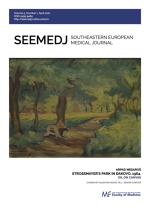Association Between Diverse Diabetic Treatments and Duration of Diabetes Mellitus According to Progression of Diabetic Retinopathy: Experience From a Small Regional Hospital
DOI:
https://doi.org/10.26332/seemedj.v5i1.175Ključne riječi:
diabetes complication;, diabetic retinopathy; , insulin-dependent diabetes;, educationSažetak
Introduction: Research objectives of present study were to examine sex and age-related specifics of diabetic retinopathy according to the therapy approach and duration of diabetes mellitus. The study also aimed to determine the association between the presence of diabetic retinopathy and diabetes duration as a prognostic factor of retinopathy progression in such patients.
Materials and Methods: The study was designed as a retrospective study and included 289 patients with diabetic retinopathy, who were treated at the Department of Ophthalmology of the General Hospital “Dr. Josip Benčević” in Slavonski Brod during the period from 2019 to 2020.
Results: 176 patients were treated with oral antidiabetic drugs (OAD), while 113 patients were insulin-dependent. The median age of patients treated with OAD was 77 years. Diabetic retinopathy was present in 35 (19.9%) patients, of whom 33 (18.8%) had non-proliferative diabetic retinopathy, while 2 patients (1.1%) had proliferative diabetic retinopathy. The median age of the insulin-dependent patients was 79 years. Diabetic retinopathy was present in 54 patients (47.8%), non-proliferative diabetic retinopathy was diagnosed in 51 patients (45.1%), while proliferative diabetic retinopathy was diagnosed in only 3 (2.7%) patients. There was a significant difference between the presence of diabetic retinopathy and diabetes duration (P<0.001), as well as between the therapy approach and diabetes duration (⍺<0.001).
Conclusion: Various hypotheses have been proposed to explain the worsening of diabetic retinopathy, and we assume that the therapy approach, duration of diabetes and HbA1c have a significant role in retinopathy progression. Hereby, we emphasize that, although there have been significant advances, there is still a pressing need for a better understanding of a new therapeutic modality, new tools for identifying high-risk patients and continued monitoring in order to intervene effectively before vision loss occurs. Further research is needed to identify and implement the best practices to increase diabetic eye screening rates in the long term.
Preuzimanja
Objavljeno
Broj časopisa
Rubrika
Licenca
Autorska prava (c) 2025 Southeastern European Medical Journal

This work is licensed under a Kreativni Commons Attribution-NonCommercial-NoDerivatives 4.0 International License.



